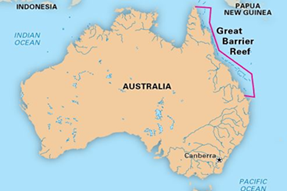

Context
Australia is opposed to the recommendation made in the joint report by IUCN and UNESCO’s World Heritage Centre, to include the Great Barrier Reef (GBR) on the List of “World Heritage in Danger”.
About
The Great Barrier Reef (GBR):
- It is the World’s most extensive and spectacular “Coral Reef”ecosystem composed of over 2,900 individual reefs and 900 islands.
- The reef is located in the Coral Sea (North-East Coast),off the coast of Queensland, Australia.
- This reef structure is composed of and built by billions of tiny organisms, known as coral polyps.
- It was selected as a World Heritage Site in 1981.

What is a world heritage site?
- World Heritage Sites are cultural and/or natural sites considered being of ‘Outstanding Universal Value, which has been inscribed on the World Heritage List by the World Heritage Committee.
Inscribing a site on the List of World Heritage in Danger”
- This list is designed to inform the international community of conditions:
- That threatens the very characteristics of a property inscribed on the World Heritage List.
- To encourage corrective action.
- It allows the WHC:
- To allocate immediate assistance from the World Heritage Fund to the endangered property
- To gather international support and attention to the site.
When a site is added to World Heritage Site?
According to the World Heritage Convention, the World Heritage Committee (that administers the Convention) adds World Heritage Sites to the danger list if the site satisfies one of the criteria in either of the two categories below.
- For cultural properties:
- Ascertained Danger:
-
- serious deterioration of materials;
- serious deterioration of the structure and/or ornamental features;
- Potential Danger:
-
- modification of the juridical status of the property diminishing the degree of its protection;
- lack of conservation policy;
- For natural properties:
- Ascertained Danger
-
- A serious decline in the population of the endangered species or the other species of Outstanding Universal Value for which the property was legally established to protect, either by natural factors such as disease or by human-made factors such as poaching.
- Severe deterioration of the natural beauty or scientific value of the property, as by human settlement, construction of reservoirs which flood important parts of the property, industrial and agricultural development including the use of pesticides and fertilizers, major public works, mining, pollution, logging, firewood collection, etc.
- Potential Danger:
-
- a modification of the legal protective status of the area
- planned resettlement or development projects within the property or so situated that the impacts threaten the property
Why Australia is saying ‘NO’?
It’s multiple other interests taking a back seat:
- It has to phase out “gill net fishing” which indiscriminately harms marine life.
- It would have to make substantial investments to compensate present fishing method.
- Losing political goodwill amongst fishermen who form a voting bloc in Queensland.


